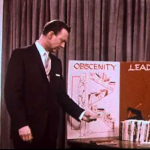Brownmiller’s statement probably had a lot to do with the anti-SM strain of feminism in the late 1970s and early 1980s. In her view, masochism is merely a myth of patriarchy, an excuse for rape.
Within the current Gay Liberation Movement there is a boisterous minority contained within the outposts of leather bars that would like to see consensual sadomasochism, including the paraphernalia of whips and handcuffs, accepted as a civil-libertarian right, as drag queens are demanding the right to dress in traditionally female attire. Again, what is a feminist to make of this? Does homosexual sadomasochism have its own, peculiarly male, dynamic, or is it an aberration masquerading as the newest issue? The international language of sadomasochism, from the prison argot to the intellectual’s musing, and its immutable rites and practices are too revealing to ignore. Sartre explains for Genet that “the rump is the secret femininity of males, their passivity,” and both men agree that passivity is defined as being on the receiving end of a penis. In the man-on-man definition, fellatio, too, is a passive act and cocksucker is the equivalent of chicken. Hardly by accident, sadomasochism has always been defined by male and female terms. It has been codified by those who see in sadism a twisted understanding of their manhood, and it has been accepted by those who see in masochism the abuse and pain that is synonymous with Woman. For this reason alone sadomasochism shall always remain a reactionary antithesis to women’s liberation.
Although I believe that masochism is often a dynamic in homosexuality, I am not suggesting that it is in some way integral to noncoercive, one-sex relationships or predilections. More significant, perhaps, than the masochistic factor has been the blanket assumption of masochism– in the belief that all male homosexuals wish to be forcibly violated– that has been used with telling effect by heterosexual men who wish to avoid the implications and reality of a man’s rape by other men. Here again, the parallels to the woman’s experience are obvious. I have listened more than once to the story of a homosexual youth who tried without success to convince his local precinct that he was beaten and raped by some strangers he met in a gay bar and thoughtlessly decided to entertain at home. To the cops in the precinct the raped youth was nothing more than a faggot who was “asking for it.” Along the same lines, T.E. Lawrence’s account of his gang rape by the soldiers of the Nuri Bey in Deraa, laundered in many editions of Seven Pillars of Wisdom, has been quartered and dissected by a host of Lawrence scholars who feel that the “truth” of the brutal sodomizing hangs on Lawrence’s alleged or suppressed homosexuality. Indeed, I have heard the argument that Lawrence’s sphincter muscles should have been sufficient to ward off unwelcome penetration. Correspondingly, some modern sociologists have tried to downplay homosexual rape in American prisons by making use of the biased belief that– this is a direct quote from an accepted source– “there is in some question, as in heterosexual situations, as to whether the situation is really in fact rape or whether it is a seduction which has simply gone wrong.”
Brownmiller, Susan. Against Our Will: Men, Women and Rape. New York: Fawcett Columbine. 1975 Pg.263-264



